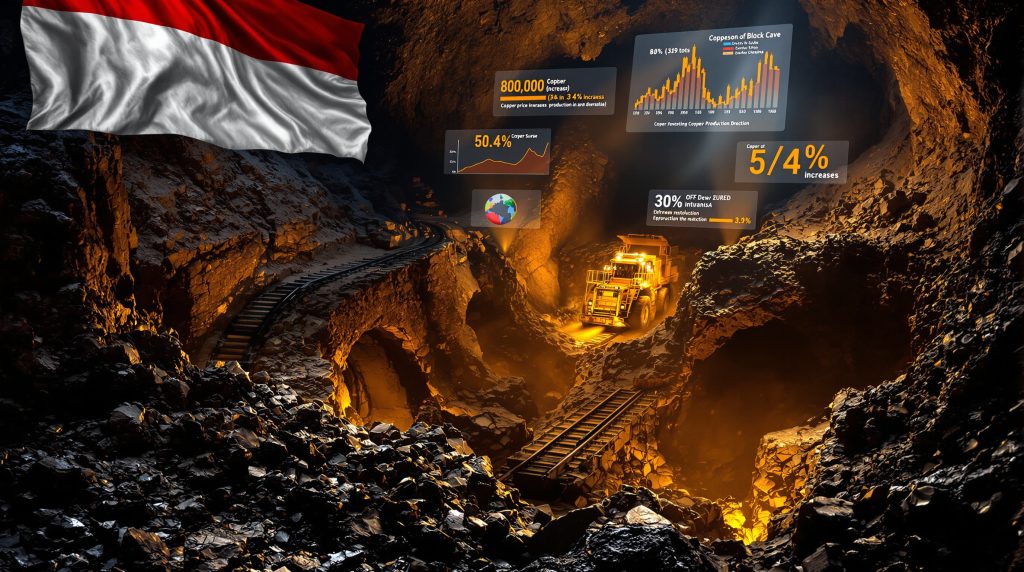What Makes the Grasberg Block Cave Mud Rush a Defining Mining Disaster?
The September 2025 catastrophe at Indonesia's Grasberg Block Cave represents one of the most devastating underground mining incidents in recent history. This Grasberg Block Cave mud rush tragedy claimed seven lives and triggered a global copper supply crisis, fundamentally altering how the mining industry approaches block cave operations in challenging geological environments.
The incident at PT Freeport Indonesia's flagship operation occurred on September 8, 2025, at 10:00 PM Western Indonesia Time, when massive volumes of water-saturated material suddenly mobilised and surged through the underground workings with devastating speed. The tragedy unfolded in production block PB1C, one of five active production areas within the Grasberg Block Cave complex.
Understanding the Scale of the Disaster
The Grasberg Block Cave mud rush tragedy involved torrents of waterlogged material that overwhelmed safety systems and infrastructure across multiple mine levels. This catastrophic flow moved through drawpoints in the affected production block, creating a cascade effect that trapped workers in underground areas below the initial impact zone.
The sheer volume and velocity of the material flow demonstrated how quickly underground conditions can deteriorate beyond the capacity of even sophisticated mining operations. Emergency response protocols were immediately activated, but the extent of the damage made rescue operations extraordinarily challenging and dangerous.
Timeline of Events Leading to the Tragedy
The disaster timeline reveals the rapid progression of events that characterised this Grasberg Block Cave mud rush tragedy:
- September 8, 2025, 10:00 PM: Initial mud rush occurs in production block PB1C
- September 8-20, 2025: Intensive rescue operations involving emergency teams and Indonesian government authorities
- September 20, 2025: First two deceased miners located after nearly two weeks of search efforts
- October 6, 2025: Remaining five victims recovered, concluding the month-long recovery operation
How Did the Mud Rush Occur at Grasberg Block Cave?
Block cave mining operations create inherently unstable conditions where massive volumes of rock are intentionally collapsed in controlled sequences. However, the specific geological and hydrological conditions at Grasberg created unprecedented risks that culminated in this Grasberg Block Cave mud rush tragedy.
The incident demonstrates the complex interplay between mining methodology and environmental factors in tropical regions. Block cave mining relies on gravitational forces to collapse and extract ore, but this process becomes significantly more dangerous when groundwater saturation reaches critical levels. Furthermore, copper price insights suggest that market pressures for increased production may influence operational decisions during challenging periods.
The Geological Factors Behind the Catastrophe
Central Papua's geological characteristics played a crucial role in the Grasberg Block Cave mud rush tragedy. The region's complex rock formations, combined with intense tropical precipitation patterns, create conditions where water infiltration can destabilise previously stable underground workings.
The area's mining history, transitioning from decades of open-pit operations to underground block cave methods, added additional complexity to the geological environment. Legacy effects from surface mining operations can influence groundwater flow patterns and rock stability in ways that may not become apparent until catastrophic events occur.
Infrastructure Vulnerabilities Exposed
The tragedy revealed how rapidly underground mining infrastructure can be compromised when geological conditions exceed design parameters. The incident damaged critical systems across multiple areas of the mine complex, demonstrating the interconnected nature of underground operations.
Key Infrastructure Systems Affected:
- Mobile mining equipment destroyed or buried under debris
- Rail transportation networks severed across multiple levels
- Electrical power systems disabled throughout affected zones
- Communication networks disrupted, complicating rescue efforts
- Emergency refuge chambers isolated from rescue access points
The comprehensive nature of this infrastructure damage explains why the impact extended beyond the initially affected production block PB1C to influence operations across the entire Grasberg Block Cave complex. This situation highlights the importance of modern mine planning approaches that incorporate redundancy and resilience into critical systems.
What Was the Human Cost of the Grasberg Tragedy?
Seven miners lost their lives in this tragedy, highlighting the extreme dangers faced by underground workers in complex geological environments. The extended recovery operation demonstrated both the dedication of rescue teams and the challenging conditions they faced in accessing affected areas.
The human toll extends beyond the immediate fatalities to encompass the psychological impact on rescue personnel, mining families, and the broader mining community. The month-long uncertainty during recovery operations created additional trauma for those connected to the victims.
Search and Recovery Operations
Emergency response teams and Indonesian government authorities initiated immediate rescue efforts, implementing multiple strategies to reach the trapped workers. The complexity of the underground environment, compounded by the mud rush damage, made these operations extraordinarily difficult and time-consuming.
Recovery efforts involved:
- Opening access routes through damaged underground infrastructure
- Drilling operations targeting suspected worker locations
- Service level exploration including areas near refuge chambers
- Multiple simultaneous initiatives to access different areas where workers were believed to be located
The technical challenges faced during these operations illustrate the limitations of current underground rescue technologies when dealing with catastrophic geological events. Consequently, this has prompted discussions about the need for enhanced official company updates and communication protocols during crisis situations.
Impact on Mining Families and Communities
Company leadership, including Chairman of the Board Richard C. Adkerson and President and CEO Kathleen Quirk, personally visited the site to support affected families. Their presence during this difficult period demonstrated corporate recognition of the human cost of mining operations in challenging environments.
The tragedy serves as a stark reminder of the risks undertaken by mining professionals who work in underground environments to extract the materials essential for global industrial processes.
The extended duration of recovery operations underscores the critical importance of enhanced emergency preparedness and the need for mining operations to continuously evaluate and improve their crisis response capabilities.
How Has the Disaster Affected Global Copper Markets?
The incident created immediate disruptions in global copper supply chains, with market effects that will persist for years. As one of the world's largest copper production facilities, Grasberg's operational status directly influences global commodity markets and industrial supply chains.
Initial assessments indicate that Q4 2025 sales of copper and gold would be potentially approximately 35% lower than pre-incident estimates, creating significant supply constraints during a period when global copper demand remains robust. This supply disruption has highlighted the vulnerability of copper supply chains to major mining incidents.
Immediate Market Response
The tragedy sent immediate shockwaves through commodity markets as traders and analysts assessed the supply implications. The incident occurred at a facility that represents a substantial portion of global copper production, making any disruption significant for international markets.
Market participants quickly recognised that this was not a minor operational disruption but a major supply event that would require months or years to fully resolve. The comprehensive nature of the infrastructure damage suggested that recovery would be complex and time-consuming.
Production Impact Assessment
The incident occurred in production block PB1C but resulted in damage to infrastructure required to support other production areas throughout the Grasberg Block Cave complex. This interconnected damage pattern explains why the entire facility required operational suspension, amplifying the supply impact beyond what the location of the initial incident might suggest.
Projected Recovery Timeline:
| Period | Production Status | Expected Capacity |
|---|---|---|
| Q4 2025 | Complete suspension | 0% of normal output |
| H1 2026 | Limited restart (PB2, PB3) | Partial restoration |
| Q2 2026 | Three-block operation | Moderate capacity |
| 2027 | Full operational recovery | Pre-incident levels |
This extended recovery timeline reflects the comprehensive nature of infrastructure reconstruction required before normal operations can resume.
What Are the Long-term Production Implications?
The tragedy will influence global copper supply for years, with complete operational recovery not expected until 2027. This timeline reflects both the extent of infrastructure damage and the cautious approach required for safe operational restart.
The phased recovery approach prioritises worker safety while systematically restoring productive capacity across different areas of the mine complex. This methodical strategy, while extending the recovery timeline, aims to prevent similar incidents during the restart process.
Phased Restart Strategy
PT Freeport Indonesia has outlined a careful sequence for operational recovery that begins with the least affected production areas. The first half of 2026 will see initial restart activities focused on production blocks PB2 and PB3, which sustained less damage during the incident.
Recovery Sequence:
- Early 2026: PB2 and PB3 production blocks restart
- Q2 2026: PB1S production block comes online
- 2027: Complete restoration of PB1C and full operational capacity
- 2027 target: Return to pre-incident production estimates
This conservative timeline allows for comprehensive safety assessments and infrastructure rebuilding at each stage of the recovery process.
Infrastructure Reconstruction Requirements
The company must complete extensive damage assessments and reconstruction across multiple underground systems before operations can safely resume. The tragedy caused comprehensive damage that extends far beyond the initial incident location.
Critical Systems Requiring Assessment and Repair:
- Mobile equipment: Heavy machinery buried or damaged by mud flow
- Rail infrastructure: Underground transportation networks severed
- Ore chutes: Material handling systems compromised
- Electrical systems: Power distribution networks disrupted
- Communication systems: Emergency and operational communications disabled
- Supporting infrastructure: Ventilation, pumping, and safety systems affected
The interconnected nature of these systems means that reconstruction must be carefully coordinated to ensure all components function effectively together when operations resume.
How Are Investigators Analyzing the Root Causes?
PT Freeport Indonesia has commenced a comprehensive investigation to identify the underlying causes of the tragedy. This investigation includes external experts and will address both root cause analysis and recommendations to prevent similar incidents in the future.
The involvement of external experts demonstrates the company's commitment to objective analysis and the recognition that preventing similar tragedies requires perspectives beyond internal assessments. This approach aligns with industry best practices for investigating major mining incidents.
Technical Investigation Scope
The investigation encompasses multiple technical disciplines and operational areas to develop a complete understanding of how the incident occurred. This comprehensive approach examines both immediate trigger factors and underlying systemic issues that may have contributed to the incident.
Primary Investigation Areas:
- Geological conditions: Rock stability and groundwater behaviour analysis
- Operational procedures: Mining methodology and safety protocol evaluation
- Equipment performance: Infrastructure response to extreme conditions
- Environmental factors: Weather patterns and hydrological influences
- Emergency response: Effectiveness of crisis management procedures
Safety Protocol Reassessment
The tragedy has prompted industry-wide examination of safety protocols for block cave operations, particularly in regions with challenging geological and climatic conditions. The incident serves as a catalyst for advancing safety practices across the global mining industry.
This reassessment extends beyond the immediate investigation to influence how mining companies worldwide approach risk management in similar operational environments. The lessons learned from this tragedy will likely influence mining engineering practices for decades to come.
What Does This Mean for Block Cave Mining Worldwide?
The incident represents a watershed moment for block cave mining operations globally, particularly in regions with similar geological and climatic challenges. The incident demonstrates how catastrophic events can overwhelm even sophisticated mining operations with advanced safety systems.
Mining companies operating block cave systems worldwide are reassessing their risk management protocols and emergency response capabilities. The tragedy has highlighted the need for enhanced monitoring systems and improved understanding of how extreme geological conditions can interact with mining operations. In addition, the broader mining industry evolution must now account for these emerging risks and challenges.
Industry-Wide Safety Implications
The tragedy has prompted mining companies globally to evaluate their own operations for similar risk factors. The incident demonstrates that even well-established mining operations with extensive experience can face unprecedented challenges when geological conditions exceed design parameters.
This evaluation process extends beyond immediate safety concerns to encompass broader questions about operational resilience and the ability to respond effectively to catastrophic events. The mining industry is examining how to better prepare for and respond to similar incidents.
Risk Assessment Evolution
The tragedy has accelerated discussions about enhanced risk assessment methodologies for block cave operations, particularly regarding the interaction between geological conditions and mining infrastructure. Traditional risk models may require updating to better account for extreme scenarios.
Mining companies are evaluating whether current risk assessment frameworks adequately capture the potential for rapid, catastrophic changes in underground conditions. This reassessment may lead to new industry standards for monitoring and predicting geological hazards in block cave environments.
How Will This Tragedy Shape Future Mining Practices?
The incident will likely influence mining engineering practices, safety protocols, and risk assessment methodologies for decades to come. The incident serves as a powerful reminder of the need for continuous innovation in mining safety technology and emergency response capabilities.
The tragedy has highlighted the limitations of current monitoring and prediction systems when dealing with rapid-onset geological events. Future mining practices will likely incorporate more sophisticated monitoring technologies and enhanced emergency response systems designed to function effectively during catastrophic events. For instance, data-driven operations are becoming increasingly important for real-time risk assessment.
Enhanced Monitoring Technologies
The tragedy has demonstrated the need for advanced geological monitoring systems capable of detecting early warning signs of instability in block cave environments. Current monitoring technologies may require significant enhancement to provide adequate warning of catastrophic events.
Future monitoring systems will likely incorporate:
- Real-time hydrological monitoring: Continuous assessment of groundwater conditions
- Advanced geological sensors: Enhanced detection of rock mass stability changes
- Predictive modelling systems: Improved forecasting of potential failure scenarios
- Integrated alert networks: Seamless communication of threat assessments
- Automated response triggers: Systems that activate emergency procedures automatically
Emergency Response Evolution
Mining companies are reassessing emergency response capabilities, focusing on systems that remain functional during catastrophic events. Traditional emergency response protocols may prove inadequate when infrastructure is rapidly compromised.
Future emergency response systems will likely emphasise redundancy, rapid deployment capabilities, and the ability to function independently of primary mine infrastructure. This evolution reflects recognition that catastrophic events can disable conventional emergency response resources.
The transformation of mining practices following this tragedy will likely accelerate adoption of remote monitoring technologies and automated systems that reduce human exposure to high-risk underground environments while maintaining operational effectiveness.
What Are the Broader Implications for Indonesia's Mining Sector?
As one of Indonesia's most significant mining operations, the tragedy has implications for the country's resource sector and economic planning. The incident affects not only immediate operational concerns but also broader questions about mining safety regulation and industry oversight.
Indonesia's position as a major global supplier of copper and other minerals means that incidents like this tragedy can influence international perceptions of the country's mining sector. The response to this tragedy will likely shape future regulatory approaches and industry practices throughout Indonesia. Furthermore, the discovery of a major copper system in Argentina highlights the global competition for copper resources.
Economic Impact on Papua Region
The extended shutdown of Grasberg Block Cave operations affects local employment, regional economic activity, and community development programmes. The tragedy has created economic ripple effects that extend far beyond the immediate mining operation.
Local communities that depend on mining-related employment and economic activity face uncertainty during the extended recovery period. The phased restart approach, while prioritising safety, means that full economic recovery for the region will require years rather than months.
Regulatory Considerations
Indonesian mining authorities are likely examining whether current safety regulations and oversight procedures are adequate for managing risks associated with complex mining operations like Grasberg Block Cave. The tragedy may prompt regulatory updates designed to prevent similar incidents.
This regulatory review process could influence mining practices throughout Indonesia, potentially leading to enhanced safety requirements, more frequent inspections, and updated emergency response standards for major mining operations.
Lessons Learned from the Grasberg Block Cave Tragedy
The incident offers critical lessons for the global mining industry about risk management, emergency preparedness, and the challenges of operating in complex geological environments. These lessons extend beyond immediate safety concerns to encompass broader questions about operational resilience and crisis response.
Key Insights from the Tragedy:
- Geological monitoring systems require continuous enhancement to detect rapid-onset events
- Emergency response capabilities must remain functional when primary infrastructure fails
- Recovery operations in complex underground environments require specialised expertise and equipment
- Market impacts from major supply disruptions can persist for years after initial incidents
- Human factors remain paramount in mining safety, requiring ongoing attention to worker protection
Building Industry Resilience
The tragedy demonstrates the importance of building resilience into mining operations rather than simply focusing on incident prevention. While prevention remains critical, the ability to respond effectively when prevention fails proves equally important.
This resilience encompasses technical systems, operational procedures, emergency response capabilities, and organisational culture. The tragedy highlights how quickly situations can deteriorate and the importance of maintaining response capabilities that function effectively under extreme conditions.
Moving Forward: Preventing Future Tragedies
The tragedy serves as a catalyst for advancing mining safety practices and emergency response capabilities across the global industry. The lessons learned from this incident will influence mining engineering, safety protocols, and risk management approaches for years to come.
The investigation outcomes and recovery experiences will provide valuable insights for mining companies worldwide operating in similar geological and climatic conditions. Sharing these lessons broadly across the industry represents an important step toward preventing similar tragedies in the future.
Future Prevention Strategies:
- Enhanced risk assessment methodologies incorporating extreme scenario planning
- Advanced monitoring systems with predictive capabilities for geological hazards
- Improved emergency response protocols designed for catastrophic infrastructure failure
- Industry collaboration on safety technology development and best practices
- Regulatory evolution to address emerging risks in complex mining environments
The tragedy will be remembered not only for its immediate devastating impact but also for its role in driving important advances in mining safety and emergency preparedness. The industry's response to this tragedy will help determine whether similar incidents can be prevented in the future.
Disclaimer: This analysis is based on publicly available information as of October 2025. Production timelines, market impacts, and investigation outcomes remain subject to change as new information becomes available. Readers should consult official company announcements and regulatory updates for the most current information regarding the Grasberg Block Cave situation.
Ready to Position Yourself Ahead of Major Mining Market Movements?
Discovery Alert's proprietary Discovery IQ model delivers real-time alerts on significant ASX mineral discoveries, instantly empowering subscribers to identify actionable opportunities ahead of the broader market during volatile periods like the Grasberg supply disruption. Understand why major mineral discoveries can lead to substantial market returns whilst copper supply constraints create new investment opportunities across the mining sector.




